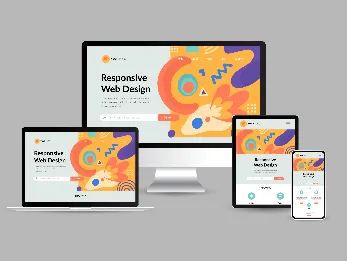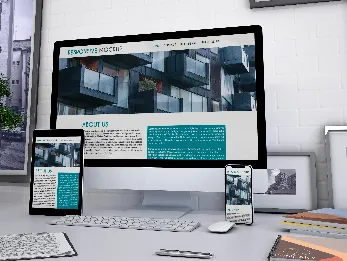AI For Website Design: 5 Ways AI Is Revolutionizing Website Design
5 mins | 30 Jul 2023

Table of Contents
1. Introduction
2. 5 Ways AI is Revolutionizing Website Design
3. Conclusion
Introduction
Artificial Intelligence is revolutionizing website design and transforming user experiences. As AI continues to make its mark across various industries, its impact on website design is becoming increasingly significant. With the growing importance of digital presence and user engagement, businesses are leveraging AI's capabilities to create personalized, interactive, and user-centric websites.
By analyzing vast amounts of user data, AI enables designers to tailor website experiences to individual preferences and behaviours. This personalization fosters deeper connections with users, enhancing engagement and satisfaction.
Additionally, AI automates design processes, saving time and ensuring consistency in visual elements. AI-powered chatbots and virtual assistants enhance interactions, providing real-time support and improving the user experience.
The future of website design with AI is bright for businesses seeking to stay competitive. In the following blog, we will explore the key ways in which AI is revolutionizing website design, highlighting its transformative potential and the benefits of AI in website design which it brings to businesses and users alike.
5 Ways AI is Revolutionizing Website Design
1. Use of Self-learning Algorithms
AI-powered solutions are making significant strides through the use of self-learning algorithms. These algorithms enable websites to continuously learn from user behaviour and adapt accordingly, providing personalized and engaging experiences.
The impact of AI on website design, particularly through self-learning algorithms, cannot be overstated. Let's explore this aspect and how AI revolutionizes website design.
- Intelligent Content Recommendations:
AI algorithms in website design analyze vast amounts of user data, including browsing history, preferences, and demographics. By doing so, they can provide highly targeted and personalized website experiences with content recommendations.
These recommendations are tailored to individual users, considering their interests and browsing behaviour. Through AI-powered website design, personalized content recommendations are generated, enhancing user engagement and satisfaction.
Users are more likely to spend time on websites that deliver relevant content, increasing the chances of conversion and loyalty.
- Automated Image and Video Optimization:
Visual elements such as images and videos are vital in website design. However, they can also impact loading times and the overall user experience. AI algorithms come to the rescue by automating image and video optimization.
These algorithms analyze the visual assets and automatically adjust formats, sizes, and resolutions to ensure faster loading times without compromising quality. By optimizing images and videos, AI-powered website design enhances user experiences and reduces bounce rates, ultimately improving website performance.
- Predictive User Behavior Analysis
Understanding user behaviour is crucial for effective website design. AI algorithms excel in analyzing user interactions and data, enabling designers to predict user behaviour patterns. Designers can optimize website elements by leveraging predictive user behaviour analysis to maximize engagement and conversions.
This can involve strategically placing call-to-action buttons, optimizing navigation menus, and personalizing the user journey. Through AI-powered website design, websites can be tailored to meet user expectations, resulting in enhanced user experiences and improved business outcomes.
- Personalized Content Delivery
One of the remarkable aspects of AI-powered website design is its ability to deliver personalized content. AI algorithms analyze user data to provide dynamic and tailored content, including demographics, browsing history, and preferences.
Personalized content delivery enhances user engagement and encourages longer website visits. Users are more likely to find value in websites offering content that aligns with their interests and needs. Through AI-powered website design, personalized content delivery becomes a reality, creating a more immersive and relevant user experience.
- Real-time User Interaction
AI-driven chatbots and virtual assistants are revolutionizing user interaction on websites. These intelligent agents provide users with real-time support, recommendations, and assistance based on their needs and preferences.
Businesses can offer personalized, dynamic interactions that enhance user experiences by leveraging AI-powered website design. Chatbots can address user queries, provide product recommendations, and even assist in completing transactions. This level of real-time user interaction adds a human touch to website experiences, fostering engagement and building trust.
Further Reading: Avoid these Website Design mistakes at all costs.
2. Optimize Coding and Modularity
In website design, AI-powered solutions are revolutionizing the process by optimizing coding practices and introducing modularity. This approach enhances efficiency, flexibility, and overall website performance. Using the provided keywords, let's explore how AI transforms coding and modularity in website design.
- Automated Code Generation
AI algorithms employed in website design streamline the coding process through automated code generation. These algorithms analyze design inputs and generate clean, optimized code automatically.
This eliminates the need for manual coding and reduces the likelihood of human errors. Automated code generation ensures consistent coding practices, leading to a more stable and efficient website. Additionally, it saves time and effort, allowing designers to focus on other creative aspects of the website development process.
- Modular Design Systems
AI empowers the creation of modular design systems that promote reusability and scalability. These systems consist of modular components that can be easily reused across multiple projects. With AI-powered website design, designers and developers can create a library of pre-designed modules, including navigation menus, buttons, and other interface elements.
This approach enhances design elements' consistency, improves collaboration, and simplifies future updates and maintenance. By leveraging modular design systems, websites can be developed more efficiently and consistently.
- Code Optimization
AI algorithms play a significant role in optimizing code for website design. Through analysis and machine learning techniques, these algorithms identify areas for code improvement, such as reducing redundant or unnecessary code and optimizing algorithms for better performance. Code optimization leads to faster loading times, improved website responsiveness, and enhanced user experiences. AI-powered code optimization techniques help ensure that websites are optimized for speed and efficiency, benefiting users and website owners.
3. Understanding Big Data
With the ability to process and analyze large volumes of data, AI-powered solutions enable website designers to gain valuable insights, make data-driven decisions, and enhance user experiences. Let's explore how AI facilitates understanding big data in website design, incorporating the provided keywords.
- Data Collection and Analysis
AI algorithms can efficiently collect and analyze vast amounts of data generated by website users. This includes user interactions, browsing behaviour, demographics, and preferences. Designers can comprehensively understand user behaviour, interests, and needs by leveraging AI-powered website design. This data-driven approach helps identify patterns, trends, and opportunities to optimize the website design and improve user experiences.
- User Segmentation and Targeting
Big data analytics powered by AI allows for sophisticated user segmentation and targeting. By analyzing user data, AI algorithms can group users into segments based on shared characteristics, preferences, or behaviours.
This segmentation enables designers to tailor website content, features and offers to specific user groups. AI-powered website design facilitates effective targeting strategies, ensuring users receive personalized experiences that resonate with their unique needs and preferences.
- Continuous Optimization and Improvement
Understanding big data through AI-powered website design enables continuous optimization and improvement. By monitoring user behaviour and analyzing data, AI algorithms can identify areas for improvement and suggest actionable insights.
Designers can leverage this information to refine website elements, enhance user experiences, and optimize conversions. Continuous improvement based on big data analysis ensures that websites remain relevant, effective, and competitive in a rapidly evolving digital environment.
Further Reading: Best AI Tools for Building Websites.
4. Simplifying Web Design:
AI is revolutionizing how websites are designed by automating repetitive tasks and providing intelligent design assistance. Let's explore how AI simplifies web design, incorporating the provided keywords.
- Smart Design Suggestion Tools
AI-powered web design tools offer intelligent suggestions for colour schemes, typography, and layout options. These tools leverage AI algorithms and established design principles to give designers valuable insights and inspiration.
Designers can input their design preferences, and the tools will generate design suggestions that align with their requirements. This empowers designers to make informed decisions and explore design options efficiently. Smart design suggestion tools simplify the design process, ensuring designers can create visually appealing and user-friendly websites.
- Consistency in Design Elements
AI plays a significant role in maintaining consistency in design elements throughout the website. With AI-powered web design tools, designers can define and save design styles, such as font choices, colour palettes, and spacing guidelines.
These predefined styles can be applied consistently across various pages and sections of the website. This ensures a cohesive visual identity and user experience. AI-powered design tools help designers maintain consistency, creating a polished and professional-looking website.
- Rapid Prototyping and Iteration
AI-powered web design facilitates rapid prototyping and iteration. Designers can quickly generate interactive prototypes based on their initial designs. These prototypes simulate user interactions, allowing designers to test and refine the website's usability and functionality.
AI algorithms can analyze user feedback and behaviour, providing insights for iterative improvements. Rapid prototyping and iteration enable designers to create user-centric websites that meet their target audience's evolving needs and expectations.
5. Dynamic Customization Options:
Dynamic customization options allow websites to adapt and personalize their content, layout, and user experiences based on user preferences and behavior. Let's explore how AI enables dynamic customization in website design, incorporating the provided keywords.
- Personalized Content Recommendations
AI algorithms analyze user data, including browsing history, demographics, and preferences, to provide personalized content recommendations. Websites can dynamically customize the content displayed to individual users based on their interests and previous interactions.
By leveraging AI-powered website design, personalized content recommendations enhance user engagement, increase time spent on the website, and improve the likelihood of conversions. Users feel valued and are more likely to return to websites that offer tailored content experiences.
- Adaptive Layout and Design
AI enables websites to adapt their layout and design dynamically based on user preferences and device capabilities. AI-driven Responsive Web Design techniques have existed for some time, but AI takes it further by analyzing user behaviour and context.
Websites can adjust the layout, font sizes, and element placements to optimize the user experience for different devices, screen sizes, and orientations. This dynamic customization ensures that websites are visually appealing, easy to navigate, and accessible across various platforms.
- Behaviour-based User Experiences
AI algorithms track user behaviour and interactions on websites, allowing for behaviour-based customization of user experiences. Websites can dynamically adjust content presentation, recommendations, and calls to action based on user actions.
For example, if a user frequently engages with specific types of content, the website can prioritize similar content in future visits. By leveraging AI-powered website design, behaviour-based user experiences enhance engagement, provide relevant information, and guide users toward desired actions.
Further Reading: Tips to Improve CTR on your website.
Conclusion
In conclusion, the advent of AI has revolutionized website design, transforming how we create and interact with digital platforms. AI is revolutionizing website design in several key ways.
Firstly, AI empowers designers to create personalized websites that cater to individual users' unique preferences and needs. By analyzing vast data, AI algorithms can provide personalized recommendations, customized content, and tailored user experiences, ultimately enhancing user engagement and satisfaction.
Secondly, AI enables the development of interactive websites by implementing chatbots, virtual assistants, and voice recognition systems. These intelligent features provide real-time support, improve user engagement, and create interactive and immersive experiences for website visitors.
Furthermore, AI automates various design processes, such as generating layouts, colour schemes, and typography. This automation in website design using AI saves designers time and ensures consistency and cohesiveness in the overall design, resulting in visually appealing and user-friendly websites. AI-generated Website Layouts are much more responsive as well.
Moreover, AI-based analytics and predictive modelling help businesses gain valuable insights into user behaviour, preferences, and trends. This data-driven approach allows for informed decision-making, optimization of website performance, and targeted marketing strategies.
In this competitive market, businesses and individuals must embrace AI technologies. By harnessing the transformative potential of AI in website design, they can create personalized, interactive, and user-centric websites that stand out from the crowd. Embracing AI is the key to staying ahead and delivering exceptional experiences that keep users returning for more.
Author

Share
Share
Related

Polymers, Innovation, And A Modern Website: The Goldstab Organics Journey
5 mins : 10 Nov 2025

From Friction to Finish Line: The God of Sports Digital Transformation
6 mins : 17 Sept 2025

The Future Of Responsive Web Design: Emerging Trends, Innovations And Predictions In 2024
7 mins : 26 Apr 2024
Other Articles

Responsive Web Design: Understanding The Basics For Seamless User Experiences
7 mins : 29 Apr 2024

Everything You Should Know About The Ideal Screen Size For Responsive Design
6 mins : 26 Apr 2024

Enhance Your Web Design Creativity with Google Web Designer
4 mins : 17 Nov 2023
